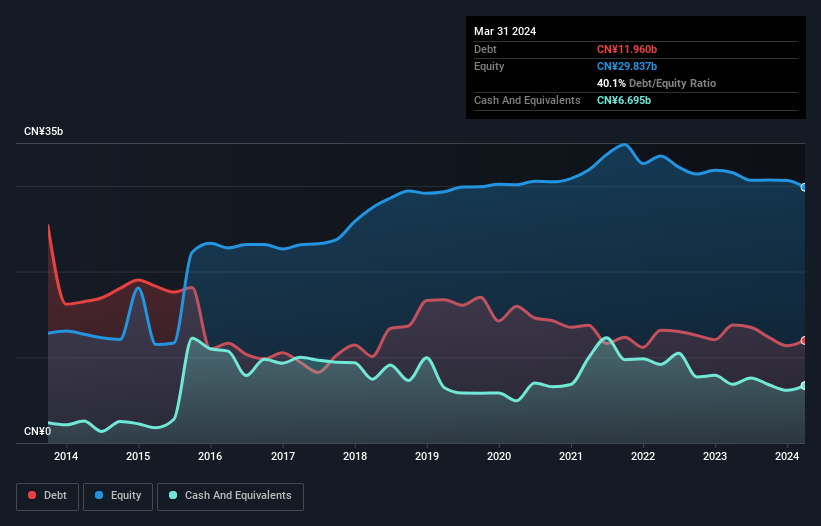- China
- /
- Metals and Mining
- /
- SHSE:600022
Health Check: How Prudently Does Shandong Iron and Steel (SHSE:600022) Use Debt?

Legendary fund manager Li Lu (who Charlie Munger backed) once said, 'The biggest investment risk is not the volatility of prices, but whether you will suffer a permanent loss of capital.' So it seems the smart money knows that debt - which is usually involved in bankruptcies - is a very important factor, when you assess how risky a company is. We can see that Shandong Iron and Steel Company Ltd. (SHSE:600022) does use debt in its business. But the more important question is: how much risk is that debt creating?
What Risk Does Debt Bring?
Debt assists a business until the business has trouble paying it off, either with new capital or with free cash flow. In the worst case scenario, a company can go bankrupt if it cannot pay its creditors. However, a more frequent (but still costly) occurrence is where a company must issue shares at bargain-basement prices, permanently diluting shareholders, just to shore up its balance sheet. Of course, plenty of companies use debt to fund growth, without any negative consequences. When we examine debt levels, we first consider both cash and debt levels, together.
Check out our latest analysis for Shandong Iron and Steel
What Is Shandong Iron and Steel's Debt?
As you can see below, Shandong Iron and Steel had CN¥12.0b of debt at March 2024, down from CN¥13.8b a year prior. However, it does have CN¥6.69b in cash offsetting this, leading to net debt of about CN¥5.27b.

How Strong Is Shandong Iron and Steel's Balance Sheet?
According to the last reported balance sheet, Shandong Iron and Steel had liabilities of CN¥32.0b due within 12 months, and liabilities of CN¥6.02b due beyond 12 months. Offsetting these obligations, it had cash of CN¥6.69b as well as receivables valued at CN¥2.24b due within 12 months. So its liabilities total CN¥29.1b more than the combination of its cash and short-term receivables.
This deficit casts a shadow over the CN¥12.9b company, like a colossus towering over mere mortals. So we'd watch its balance sheet closely, without a doubt. At the end of the day, Shandong Iron and Steel would probably need a major re-capitalization if its creditors were to demand repayment. The balance sheet is clearly the area to focus on when you are analysing debt. But you can't view debt in total isolation; since Shandong Iron and Steel will need earnings to service that debt. So when considering debt, it's definitely worth looking at the earnings trend. Click here for an interactive snapshot.
In the last year Shandong Iron and Steel had a loss before interest and tax, and actually shrunk its revenue by 14%, to CN¥89b. That's not what we would hope to see.
Caveat Emptor
Not only did Shandong Iron and Steel's revenue slip over the last twelve months, but it also produced negative earnings before interest and tax (EBIT). To be specific the EBIT loss came in at CN¥573m. When we look at that alongside the significant liabilities, we're not particularly confident about the company. We'd want to see some strong near-term improvements before getting too interested in the stock. It's fair to say the loss of CN¥728m didn't encourage us either; we'd like to see a profit. In the meantime, we consider the stock to be risky. The balance sheet is clearly the area to focus on when you are analysing debt. But ultimately, every company can contain risks that exist outside of the balance sheet. Case in point: We've spotted 2 warning signs for Shandong Iron and Steel you should be aware of, and 1 of them is potentially serious.
If you're interested in investing in businesses that can grow profits without the burden of debt, then check out this free list of growing businesses that have net cash on the balance sheet.
New: Manage All Your Stock Portfolios in One Place
We've created the ultimate portfolio companion for stock investors, and it's free.
• Connect an unlimited number of Portfolios and see your total in one currency
• Be alerted to new Warning Signs or Risks via email or mobile
• Track the Fair Value of your stocks
Have feedback on this article? Concerned about the content? Get in touch with us directly. Alternatively, email editorial-team (at) simplywallst.com.
This article by Simply Wall St is general in nature. We provide commentary based on historical data and analyst forecasts only using an unbiased methodology and our articles are not intended to be financial advice. It does not constitute a recommendation to buy or sell any stock, and does not take account of your objectives, or your financial situation. We aim to bring you long-term focused analysis driven by fundamental data. Note that our analysis may not factor in the latest price-sensitive company announcements or qualitative material. Simply Wall St has no position in any stocks mentioned.
About SHSE:600022
Mediocre balance sheet and slightly overvalued.
Market Insights
Community Narratives



